‘Through A Wilderness, Floating Down A Stream’ – Dugout Canoe, Bridge of Flowers
“I see that it is by no means useless to travel, if a man wants to see something new.” – Jules Verne
To find something new, at a map, ask questions about place names. Learn more about languages, indigenous people whose home was this continent long before any Europeans “discovered” it. Yet so many of the stories and places remain fragmented, waiting to be told, perhaps in new ways to connect the past with the present…and for future generations.
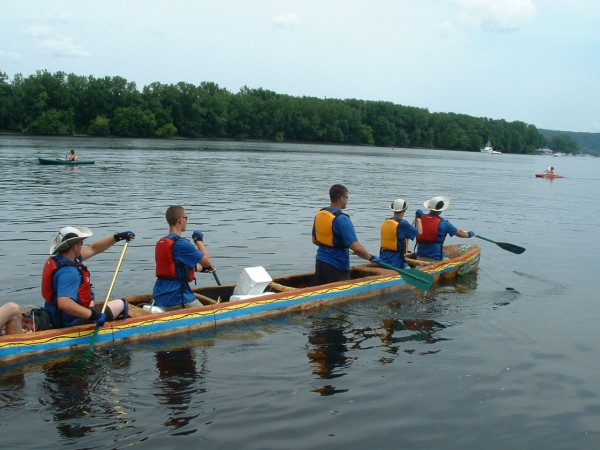
Long tidal river. A dugout canoe carved from a tree and launched at Middletown; a smudge ceremony was performed and the journey down the Connecticut River commenced. File photo MDP.
Times, they are a-changing. The past is coming to light with new technology like ground-penetrating radar and three-dimensional imaging, virtual reality tours. Collaborative partnerships are possible using social media to exchange information, add to world knowledge.
Here is an opportunity not to miss – a free archaeology expo hosted by Mashantucket Pequot Museum and Research Center, Saturday, Oct. 14, 10 a.m. to 4 p.m., Connecticut. Tour archaeology labs
visit historical sites on the reservation. Demonstrations, hands-on activities, family friendly. Watch stone tool making, bow making, atlatl throwing, more. This event will be held inside the museum’s Gathering Space with its soaring glass ceiling and acclaimed Native restaurant; there is no charge to enter the Gathering Space. However, you can extend your visit by visiting the Pequot Museum’s extensive exhibits and six theaters where general admission rates would apply.
For understanding more about layers of human history around us if you can't visit in person – there is an e-book (free PDF) about the history and culture of the Mashantucket Pequots that provides pages and pages of insight and incredible details about the region. Follow this link to the tribe's official site.
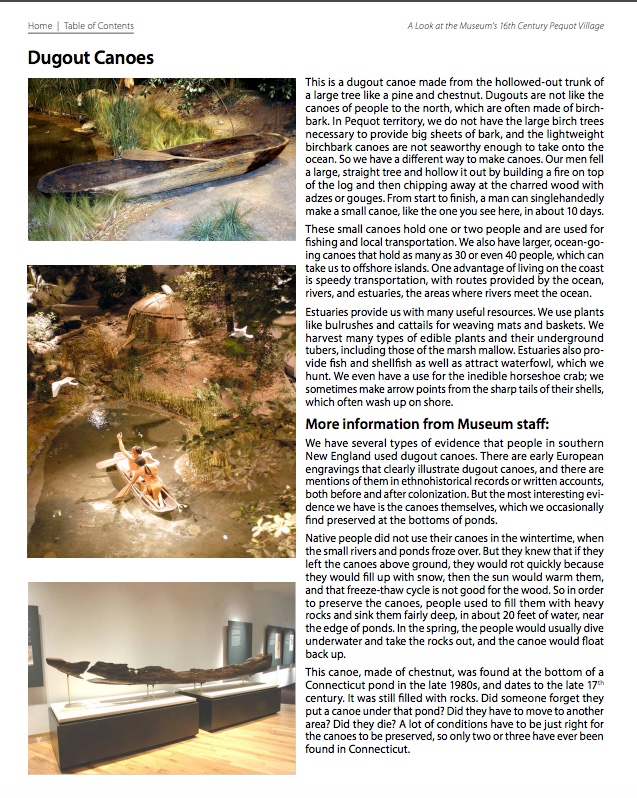
Read about a canoe made of chestnut and where it was found in Connecticut. Land use, hunting, fishing, culture, about the tribe in MPTN e-book – the canoe is page 24 – linked to this image.
Admission for the museum $20; seniors/students with ID $15; ages 6 to 17, $12. Be sure to see The Witness (included with admission), a 30-minute film about the Pequot War and human factors surrounding it. Ask about the ongoing research for the region and other archaeological events open to the public.
Mashantucket Pequot Museum & Research Center is open for visitors through Dec. 2, 2017. Hours Wednesday through Saturday, 9 a.m. to 5 p.m.; last admission at 4 p.m. In November, open Tuesday through Saturday. Restaurant open 11 a.m. to 4 p.m.; no reservations necessary.
So why not set out yourself and see where a trek leads?
The Last Green Valley is a 35-town National Heritage Corridor in eastern Connecticut and south-central Massachusetts. Also called The Quiet Corner – because it is not densely populated – and even from the air remains “distinctively dark amid the urban and suburban lights when viewed from satellites or aircraft.” Fields and forests, a surprisingly rural character defines this 1,100 square-mile area with rugged hills and the Quinebaug and Shetucket rivers. (Note that many of the names are indigenous words.)
But then there is this: “The fierce struggle known as King Philip’s War (1675-76), which turned into a war of extermination between whites and Indians, reinforced the idea of the hill country as a fearful, ominous place. The losses the Europeans had suffered in the war and the lingering recollection of its terrors kept them from moving into the largely deserted land for a full decade after the natives had been crushed.”
Imagine.
Read more in “Statement of Distinction: Why is it Green?” – a comprehensive report by Larry Lowenthal, National Park Service retired historian – Sept. 18, 2008.
Walktober events offer a way to learn about the interwoven human history by walking, canoeing, biking, riding – in a group or solo. There's music, food, new people to meet, wonders of geology and breathtaking beauty here. Here is a link to all listings.
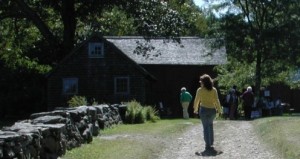
From the official site for this region: “The Last Green Valley is half the size of Grand Canyon National Park and more than 10 times that of Acadia, the largest national park in the northeast. Forest and farmland make up 77% of its 707,000 acres, yet it lies only an hour from three of New England’s four largest urban areas. Its 300,000 inhabitants reside only 2 1/2 hours from 25 million people. This relatively undeveloped rural island in the midst of the most urbanized region in the nation makes it a resource of local, regional, and national importance.
“Congress designated this region as The Last Green Valley National Heritage Corridor, recognizing the region as a unique national resource. Congress included 35 towns, 26 in Connecticut and 9 in Massachusetts. The Massachusetts communities are: Brimfield, Charlton, Dudley, E. Brookfield, Holland, Oxford, Southbridge, Sturbridge, and Webster. The Connecticut municipalities are: Ashford, Brooklyn, Canterbury, Chaplin, Coventry, Eastford, Franklin, Griswold, Hampton, Killingly, Lebanon, Lisbon, Mansfield, Norwich, Plainfield, Pomfret, Preston, Putnam, Scotland, Sprague, Sterling, Thompson, Union, Voluntown, Windham, and Woodstock.
“The first and most basic reason for distinctiveness is the rugged nature of the land itself, broken by streams and wetlands that made access difficult. The rivers, navigable only as far as Norwich, did not provide a key to the interior. When English settlers arrived in New England in the 1620s and 1630s they meant to stay, as the name itself confirms. However, their numbers were few, the country was vast, and its wooded interior seemed forbidding; so the first colonies clung to the coast or pushed up the Connecticut River Valley. Natural meadows and land already cleared by the natives looked more attractive to English eyes than hills covered with gloomy forests. Ringed by settlement on three sides, the Quinebaug-Shetucket region remained largely wilderness for more than two generations longer.”
The glorious spectacle of autumnal leaves is starting, right now. Look up, look around.
Most destinations in the Northeast are reachable by vehicle within a few hours. No telling what will be found along the route. Quirky flotsam and jetsam of life may still be found in the foothills, crooks and crannies of the region. Carved, crafted, built structures that reflect the people who live within. The diversity of farms, products, people and terrain – from the Atlantic to Long Island Sound, lakes, streams, ponds and mountains – includes:
A visit to the Bridge of Flowers in Shelburne Falls, Mass., is free; open until the end of October. Go soon, though, since cold mornings will wither anything blooming on the bridge. An amazing place to visit – even to see what creative re-use of a span of transportation history can do for attracting visitors. “In 1928, some had an idea…” Go see how an odd idea grew and bloomed. (No dogs are allowed on the bridge, but there are plenty of places nearby to take a walk.) Be sure not to miss a free self-guided tour of the river potholes nearby – there's more indigenous history to be found.
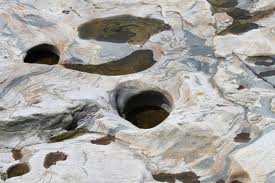
Geological oddities may be found on side trips – such as these potholes grooved and worn by swirling water and stones.
Creative re-use of an existing structure meant thinking different. And now it is a destination for travelers, good for local businesses and the community.
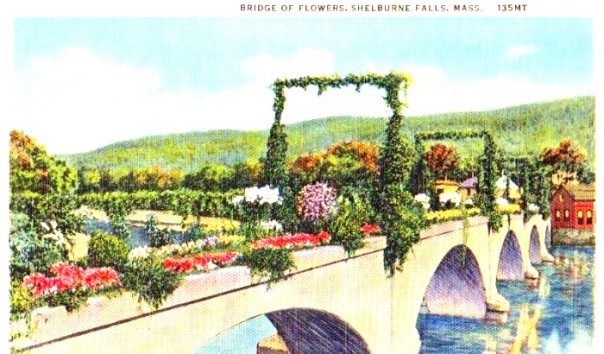
A creative community made an old trolley bridge flower – and the span has drawn people with natural beauty ever since.
Go pick apples, enjoy the outing. For pick your own places, simply search for “PYO apples” (or other seasonal fruit) + the state – from your smartphone or desktop prior to leaving on a road trip. Corn mazes, pumpkins, decorative items abound this time of year.
John James Audubon 1780-1851
Some men live for warlike deeds,
Some for women’s words.
John James Audubon
Lived to look at birds.
Pretty birds and funny birds,
All our native fowl
From the little cedar waxwing
To the Great Horned Owl.
Let the wind blow hot or cold,
Let it rain or snow,
Everywhere the birds went
Audubon would go.
Scrambling through a wilderness,
Floating down a stream,
All around America
In a feathered dream.
– Stephen Vincent Benet
Looking for more? Other listings for outings and places for the extended weekend include Native American events. Find the real – check out your opportunities for a short or long outing on our Let's Go Ag • Events page. Events added as we find them and change often. We're actively looking for places on the Connecticut River for scenic views, enjoying a fine meal or a picnic and a hike – and other venues to share with readers. To submit your listing, event, or interesting place for a story, send to editorccb(at)gmail.com.


